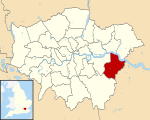Red House is a significant Arts and Crafts building located in Bexleyheath, south-east London, England. Co-designed in 1859 by the architect Philip Webb and the designer William Morris, it was created to serve as a family home for Morris. Construction was completed in 1860.
Following an education at the University of Oxford, Morris decided to construct a rural house for himself and his new wife, Jane Morris, within a commuting distance of central London. Purchasing a plot of land in what at the time was the village of Upton in Kent, he employed his friend Webb to help him design and construct the house, financing the project with money inherited from his wealthy family. Morris was deeply influenced by Medievalism and Medieval-inspired Neo-Gothic styles are reflected throughout the building's design. It was constructed using Morris' ethos of craftsmanship and artisan skills and is an early example of what came to be known as the Arts and Crafts movement.
A number of Morris' friends visited, most notably the Pre-Raphaelite painters Edward Burne-Jones and Dante Gabriel Rossetti, both of whom aided him in decorating the House; various Burne-Jones wall murals remain. While at Red House, Morris was involved in the formation of his design company, Morris, Marshall, Faulkner & Co., and embarked on his earliest wallpaper designs. It was also here that his two daughters, Jenny and May, were born. Although initially intending to live there for the rest of his life, Morris found that the house proved too expensive to run and did not suit his lifestyle. After five years, he moved his family to a flat in Queen Square, Bloomsbury and sold the property.
Red House remained a private residence for various individuals from 1866 until 2002, during which period various alterations were made to the interior design. In 1950 it was designated a Grade I listed building by English Heritage. From 1952 to 1999 the architect Edward Hollamby lived at the House, initiating attempts at preservation and establishing the Friends of Red House charity in 1998. In 2003, the National Trust purchased the property, undertaking a project of conservation and maintaining it as a visitor attraction with an accompanying tea room and gift shop.








